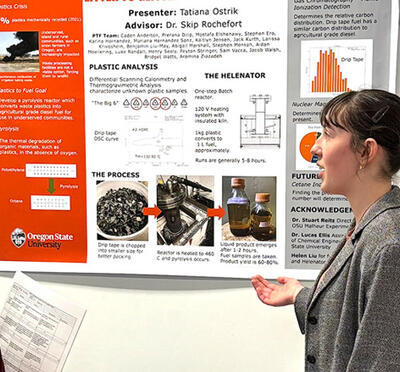Garrett Berliner (H.B.S. ’24, M.S. ’25) almost didn’t come to Oregon State University for their computer science degree, even though their brother had encouraged them to be a Beaver.
“My brother graduated from here, and he shared with me that Oregon State was a really big research institution and there were a lot of opportunities for whatever path you wanted to go down,” said Berliner, who uses gender-neutral pronouns.
Berliner initially chose New York University. But after just three weeks in New York, they came back to enroll at Oregon State. It was 2020. The world had been upended by COVID-19. Compounding the chaos, Berliner’s family was forced from their Oregon City home by the worst wildfires in state history.
“I really wanted to be closer to home because there was so much uncertainty in the world,” Berliner said.
It’s hard to imagine how that decision could have turned out better. Berliner took advantage of a wealth of opportunities at Oregon State, including the Honors College, research, clubs, professional development programs, and internships. They also stayed an additional year to earn a master’s degree through the Accelerated Master’s Platform.
For their master’s thesis, Berliner combined their interests in computer science and education to help middle school educators find greater success in teaching computer science. Advised by Jennifer Parham-Mocello, assistant professor of computer science and Kearney Faculty Scholar, they provided local math and science teachers three types of professional development to evaluate which works best.
Taking advantage of professional development opportunities
Berliner found several professional development opportunities of their own through the College of Engineering. The most pivotal was the Leadership, Empowerment, and Purpose program, which organizes activities for students to interact with engineering professionals, including industry treks to visit companies like Blue Origin, Boeing, Bristol Myers Squibb, and Microsoft.
“I was able to ask employees about their journey to their current position, what the company culture was like, and any helpful tips or advice they’d give to nearly graduated students,” Berliner said.
Berliner’s experiences at Oregon State helped them land a summer internship in Seattle at Microsoft as a technical program manager.
“The culture at Microsoft was incredible,” they said. “I always felt like my opinions were heard and highly valued.”
The internship led to a full-time job offer, and Berliner will start as a technical program manager in the Microsoft Azure Edge + Platform team after graduation.
“I always try to keep an open mind and take advantage of any opportunities available,” Berliner said. “You never know what curiosity it could spark and where it can take you.”




